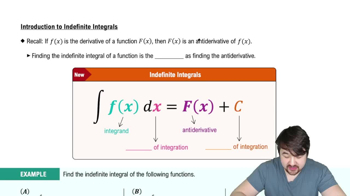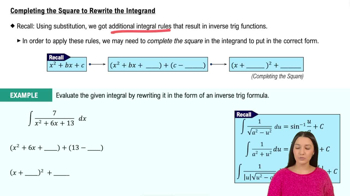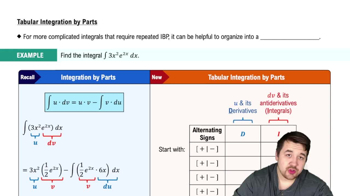4. Is a reduction formula an analytical method or a numerical method? Explain.
Table of contents
- 0. Functions7h 54m
- Introduction to Functions16m
- Piecewise Functions10m
- Properties of Functions9m
- Common Functions1h 8m
- Transformations5m
- Combining Functions27m
- Exponent rules32m
- Exponential Functions28m
- Logarithmic Functions24m
- Properties of Logarithms36m
- Exponential & Logarithmic Equations35m
- Introduction to Trigonometric Functions38m
- Graphs of Trigonometric Functions44m
- Trigonometric Identities47m
- Inverse Trigonometric Functions48m
- 1. Limits and Continuity2h 2m
- 2. Intro to Derivatives1h 33m
- 3. Techniques of Differentiation3h 18m
- 4. Applications of Derivatives2h 38m
- 5. Graphical Applications of Derivatives6h 2m
- 6. Derivatives of Inverse, Exponential, & Logarithmic Functions2h 37m
- 7. Antiderivatives & Indefinite Integrals1h 26m
- 8. Definite Integrals4h 44m
- 9. Graphical Applications of Integrals2h 27m
- 10. Physics Applications of Integrals 3h 16m
- 11. Integrals of Inverse, Exponential, & Logarithmic Functions2h 34m
- 12. Techniques of Integration7h 41m
- 13. Intro to Differential Equations2h 55m
- 14. Sequences & Series5h 36m
- 15. Power Series2h 19m
- 16. Parametric Equations & Polar Coordinates7h 58m
7. Antiderivatives & Indefinite Integrals
Indefinite Integrals
Problem 8.7.37
Textbook Question
7–40. Table look-up integrals Use a table of integrals to evaluate the following indefinite integrals. Some of the integrals require preliminary work, such as completing the square or changing variables, before they can be found in a table.
37. ∫ dx / √(x² + 10x), x >
 Verified step by step guidance
Verified step by step guidance1
Step 1: Begin by completing the square for the expression inside the square root, x² + 10x. Rewrite it as (x² + 10x + 25 - 25), which simplifies to (x + 5)² - 25.
Step 2: Substitute u = x + 5 to simplify the integral. This substitution transforms the expression into ∫ dx / √(u² - 25), where u = x + 5 and du = dx.
Step 3: Recognize that the integral now matches a standard form found in a table of integrals: ∫ dx / √(u² - a²), which corresponds to the formula ln|u + √(u² - a²)| + C.
Step 4: Apply the formula from the table of integrals, substituting u = x + 5 and a² = 25 (so a = 5). The result is ln|u + √(u² - 25)| + C.
Step 5: Replace u with x + 5 to return to the original variable. The final expression becomes ln|x + 5 + √((x + 5)² - 25)| + C.
 Verified video answer for a similar problem:
Verified video answer for a similar problem:This video solution was recommended by our tutors as helpful for the problem above
Video duration:
3mPlay a video:
Was this helpful?
Key Concepts
Here are the essential concepts you must grasp in order to answer the question correctly.
Indefinite Integrals
Indefinite integrals represent a family of functions whose derivative is the integrand. They are expressed without limits and include a constant of integration, typically denoted as 'C'. Understanding how to evaluate indefinite integrals is crucial for solving problems in calculus, as they provide the antiderivative of a function.
Recommended video:

Introduction to Indefinite Integrals
Completing the Square
Completing the square is a technique used to transform a quadratic expression into a perfect square trinomial. This method is particularly useful in integration, as it simplifies the integrand, making it easier to apply standard integral formulas. For example, the expression x² + 10x can be rewritten as (x + 5)² - 25, facilitating integration.
Recommended video:

Completing the Square to Rewrite the Integrand
Integral Tables
Integral tables are collections of standard integrals that provide quick references for evaluating common integrals. They save time and effort by allowing students to look up the integral of a function rather than calculating it from scratch. Familiarity with these tables and knowing when to use them is essential for efficiently solving integral problems.
Recommended video:

Tabular Integration by Parts

 5:04m
5:04mWatch next
Master Introduction to Indefinite Integrals with a bite sized video explanation from Patrick
Start learningRelated Videos
Related Practice
Textbook Question
23
views
